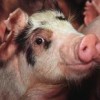 For the past six years, feed costs have continually increased and Florida has greater feed costs than the rest of the country because grain must be shipped here from where it was produced. But the Florida pork producers generally get prices above market value for their pigs because of strong demand for locally-raised foods. These Florida pork producers could become more profitable if they could significantly decrease their production costs. In Florida, pork producers have an opportunity to use citrus byproducts as a feedstuff to substantially and sustainably decrease their feed costs. This 4-page fact sheet was written by J. D. Crosswhite, N. B. Myers, A. T. Adesogan, J. H. Brendemuhl, D. D. Johnson, and C. C. Carr, and published by the UF Department of Animal Sciences, August 2012.
For the past six years, feed costs have continually increased and Florida has greater feed costs than the rest of the country because grain must be shipped here from where it was produced. But the Florida pork producers generally get prices above market value for their pigs because of strong demand for locally-raised foods. These Florida pork producers could become more profitable if they could significantly decrease their production costs. In Florida, pork producers have an opportunity to use citrus byproducts as a feedstuff to substantially and sustainably decrease their feed costs. This 4-page fact sheet was written by J. D. Crosswhite, N. B. Myers, A. T. Adesogan, J. H. Brendemuhl, D. D. Johnson, and C. C. Carr, and published by the UF Department of Animal Sciences, August 2012.
http://edis.ifas.ufl.edu/an282
Tag: Joel H. Brendemuhl
Facts and Frequently Asked Questions About Lean, Finely-Textured Beef (AN281)
 Two very similar finely-textured beef products available commercially and produced from slightly different patented processes have received an increased amount of media attention recently, where they have been referred to as “pink slime.” This 4-page fact sheet is intended to answer some of the consumer questions that have arisen as a result of this increased attention. Written by Chad Carr, Dwain Johnson, Joel Brendemuhl, and Larry Eubanks, and published by the UF Department of Animal Science, July 2012.
Two very similar finely-textured beef products available commercially and produced from slightly different patented processes have received an increased amount of media attention recently, where they have been referred to as “pink slime.” This 4-page fact sheet is intended to answer some of the consumer questions that have arisen as a result of this increased attention. Written by Chad Carr, Dwain Johnson, Joel Brendemuhl, and Larry Eubanks, and published by the UF Department of Animal Science, July 2012.
http://edis.ifas.ufl.edu/an281
AN202/AN202 The Effects of Freezing on the Processing Characteristics and Palatability Attributes of Fresh Pork Legs
AN202, a 5-page report by B. G. Sapp, D. D. Johnson, L. E. Eubanks, and J. H. Brendemuhl, presents the results of a study to ascertain if de-boning and vacuum packaging of fresh hams for frozen storage had any effect on the processing qualities and oxidative rancidity of the cured ham as compared to the traditional method of freezing and storing of fresh bone-in hams. Includes references. Published by the UF Department of Animal Science, May 2008.
http://edis.ifas.ufl.edu/AN202